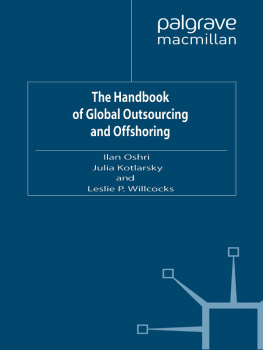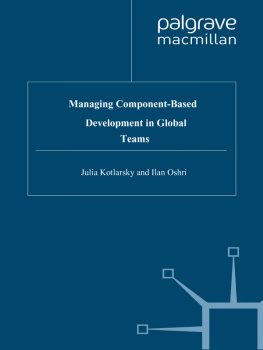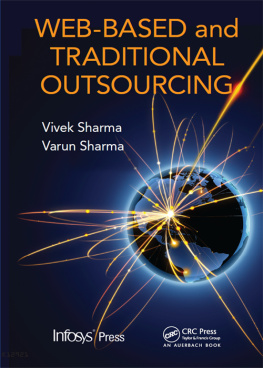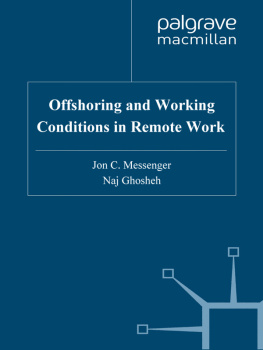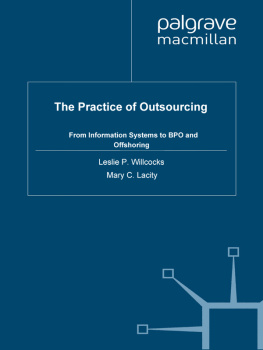The Handbook of Global Outsourcing and Offshoring
The Handbook of Global Outsourcing and Offshoring
Ilan Oshri
Associate Professor of Strategy and Technology
Management, Rotterdam School of Management,
Erasmus University, The Netherlands
Julia Kotlarsky
Associate Professor of Information Systems and Management,
Warwick Business School, UK
Leslie P. Willcocks
Professor of Technology, Work and Globalization
London School of Economics and Political Science, UK


Ilan Oshri, Julia Kotlarsky & Leslie P. Willcocks 2009
All rights reserved. No reproduction, copy or transmission of this
publication may be made without written permission.
No portion of this publication may be reproduced, copied or transmitted save with written permission or in accordance with the provisions of the Copyright, Designs and Patents Act 1988, or under the terms of any licence permitting limited copying issued by the Copyright Licensing Agency, Saffron House, 6-10 Kirby Street, London EC1N 8TS.
Any person who does any unauthorized act in relation to this publication may be liable to criminal prosecution and civil claims for damages.
The authors have asserted their rights to be identified as the authors of this work in accordance with the Copyright, Designs and Patents Act 1988.
First published 2009 by
PALGRAVE MACMILLAN
Palgrave Macmillan in the UK is an imprint of Macmillan Publishers Limited, registered in England, company number 785998, of Houndmills, Basingstoke, Hampshire RG21 6XS.
Palgrave Macmillan in the US is a division of St Martins Press LLC, 175 Fifth Avenue, New York, NY 10010.
Palgrave Macmillan is the global academic imprint of the above companies and has companies and representatives throughout the world.
Palgrave and Macmillan are registered trademarks in the United States, the United Kingdom, Europe and other countries.
ISBN-13: 978-0-230-23550-2
This book is printed on paper suitable for recycling and made from fully managed and sustained forest sources. Logging, pulping and manufacturing processes are expected to conform to the environmental regulations of the country of origin.
A catalogue record for this book is available from the British Library.
A catalog record for this book is available from the Library of Congress.
10 9 8 7 6 5 4 3 2 1
18 17 16 15 14 13 12 11 10 09
Printed and bound in Great Britain by CPI Antony Rowe, Chippenham and Eastbourne
List of Tables
1.1 Offshored functions-current landscape and expected evolution
1.2 Locations of offshoring
1.3 Offshore outsourcing risks
1.4 Strategic drivers of offshoring
1.5 Perceived risks of offshoring
2.1 Spectrum of single facility offshoring choices for a us customer
2.2 Suitability of various outsourcing models
2.3 Decision-making matrix on outsourcing
2.4 Choosing location and organization form
3.1 A.T. Kearney global services location index, 2007
3.2 Global distribution of nearshore destinations and their division into three clusters
4.1 2008 top ten information technology outsourcing companies
4.2 2008 top ten business process outsourcing companies
4.3 Top 100 global outsourcing vendors
5.1 Social capital dimensions and related practice
5.2 Organizational learning sub-processes in different IS knowledge areas
5.3 Transactive memory processes, codified and personalized directories in globally distributed teams
5.4 Organizational mechanisms and processes supporting the development of a TMS in globally distributed teams
6.1 Supplier configuration options and associated benefits and risks
6.2 Niche versus broad
6.3 The relative capabilities of two suppliers
6.4 Organizational mechanisms for building capabilities
6.5 Skills, time horizons and orientations of retained capabilities
7.1 The outsourcing lifecycle model
7.3 Second phase of the outsourcing lifecycle
7.4 Third phase of the outsourcing lifecycle
7.5 Fourth phase of the outsourcing lifecycle
7.6 Fifth stage of the outsourcing lifecycle
7.7 Sixth stage of the outsourcing lifecycle
7.8 Seventh stage of the outsourcing lifecycle
8.1 Client expectations, vendor offerings and the sweet spot
8.2 Guidelines for determining BPO governance capabilities
8.3 Characteristics of two governance models
9.1 Types of collaboration technology
9.2 Individual, team and organizational activities supporting social ties
10.1 Factors affecting firms propensity to buy bundled services
10.2 Strategic captive options: Strategic intent and local conditions
CS 1.1 Core IT capabilities model adopted by CBA
CS 2.1 BAE Systems five year financial performance
CS 2.2 Major accomplishments at BAE Systems in December 2002
List of Figures
1.1 Percentage of captive and outsourced implementations per function
4.1 Twelve supplier capabilities
6.1 Factors affecting the choice of the outsourcing partner
6.2 Nine core IS capabilities
7.1 Outsourcing lifecycle
8.1 A governing structure on a large vendor
9.1 The Waterfall approach: traditional software development lifecycle
9.2 Scenario A Globally distributed software development which is organized by phase/process step
9.3 Scenario B GDSD organized by product structure (product module)
9.4 Scenario C Only well-defined tasks distributed across locations
9.5 Scenario D GDSD based on product customization
9.6 The lifecycle of social ties in globally distributed teams
CS 1.1 New structure and responsibilities mapped against core capabilities 2001
CS 1.2 Group-wide IT&T Principles Critical to focus change
CS 1.3 WNB transformation underpinned by new sales and service platform
CS 1.4 CBA IT operating model and CIO direct reports 19972007
CS 2.1 BAE Systems vision for transforming human resources
CS 2.2 Potential deployment of Xchangings seven competencies across the four phases of an implementation plan
CS 2.3 Xchanging HR service organizational structure after initial streamlining
CS 3.1 Six-month software engineer apprentice program
CS 3.2 Four-year software engineering program
Acknowledgments
We were inspired by the insights and learning we gained from being a part of a group of passionate individuals whom we met in several events, conferences and while doing work together.
One event that in particular inspired us to start working on this book is the annual Global Sourcing Workshop (www.globalsourcing.org.uk) that we organize with our good friend Joe Rottman. This annual gathering of researchers and practitioners created a small community that discusses social, technical, and managerial aspects of global sourcing. We have learned a lot from each participant and will ever be grateful for sharing with us your experience and research. Special thanks goes to Accenture, in particular Dr. John Hindle for partially sponsoring our First and Third Workshops and for delivering great key-note speeches on both events.
Another stimulating event is the NYU-IBM global sourcing workshop organized by Prof. Natalia Levina which we attended in May 2008. One of the tracks was devoted to teaching Global Sourcing. This track helped us think about the outsourcing profession and the future needs of outsourcing professionals. In particular, we would like to thank Natalia and Prof. Erran Carmel for sharing with us their views and class experiences. We also thank Erran for contributing to this book two case studies.

